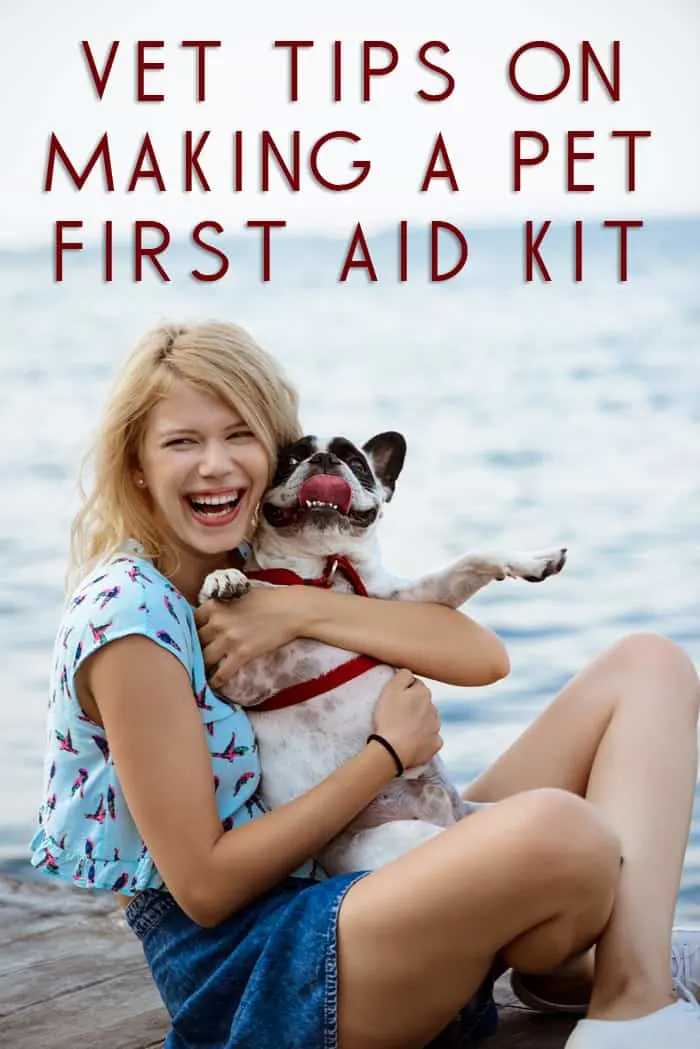This post includes affiliate links.

Emergency preparedness–whether that’s in case of natural disaster preparedness or just to prepare for emergencies around the house and on day trips–means assembling a pet first aid kit both for your car and your home.
We’ve got some tips here courtesy VCA Animal Hospitals from Dr. Donna J. Spector, DVM, DACVIM (you might have seen her on The Ellen DeGeneres show!) for making a pet first aid kit that’s ready to pick up when you have to leave in an emergency–and also useful as you go about your everyday errands and day trips with your dog.
Dr. Spector’s recommendations for making a First Aid Kit for dogs and cats include:
Put phone numbers and directions on laminated (water-proof) paper
- owner’s home
- veterinary clinic
- emergency clinic
- poison control center (FYI: the ASPCA Animal Poison Control Center Phone Number is 888-426-4435.)
Pack equipment and supplies
- muzzle or restraints (Basket Muzzle for Dogs)
- collar/leash
- scissors
- flea comb
- tweezers
- pliers/hemostats (Stainless Steel Cril Straight Pet Hemostat)
- magnifying glass
- nail clippers
- penlight or flashlight
- paper towels
- towels
- tourniquet
- cotton swabs
- cotton balls
- bandage material
- bandage tape (AUPCON Vet Wrap Cohesive Bandages)
- eye dropper
- oral syringe (BSTEAN Plastic Syringe Pack with Needles and Caps for Pet)
- thermometer and lubricating jelly (iProven Pet Thermometer)
- disposable/latex gloves
- ice cream sticks or yardstick (which may be used as splints)
- emergency ice and heat packs
- liquid dish soap
- saline solution (for rinsing wounds)
Include Nutritional Support
- rehydrating solution (pedialyte, etc)
- sugar solution (karo syrup, etc)
- Keep a collapsible bowl in the first aid kit.
Pack Medications
- activated charcoal
- alcohol
- betadine/nolvasan
- eye rinse
- triple antibiotic ointment
- ophthalmic (eye) ointment
- hydrogen peroxide
- Benadryl (diphenhydramine)
- cortisone spray/ointment
- sterile saline
- anti-diarrheal liquid or tablets
- flea and tick prevention and treatment
- styptic powder
- ear cleaning solution
- Always include any prescription medications your pet may be taking.
Check Your First Aid Kit Regularly
Dr. Spector recommends that you check your kit frequently for expired products and restock as needed.
Be sure to pay close attention to the expiration dates on the hydrogen peroxide and antibiotic ointments, and ask your veterinarian for advice on other first aid kit contents specifically for your pet.
Pack the Kit Carefully!
Don’t forget: tuck your new pet first aid kit in a water-proof plastic container for safekeeping!
- Taking Your Dog to See Santa: Tips for a Jolly Visit! - December 7, 2023
- The Pug Dog Price Tag: What You Need to Know Before You Get Your Pug - September 7, 2022
- National Microchipping Month {How it might save your dog’s life} - May 23, 2022
